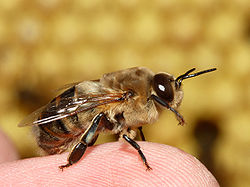So tonight I decided to post on our observation hive we had at the Forest Festival. It will make me feel like we accomplished something for the month related to our little gals. Besides, I promised you all I would tell you about our bee adventure.
One of the best parts of having the observation hive was...well...being able to observe! All of our experience at looking at a hive up until this point was an abrupt disruption to the hive to check for brood and honey stores. Having the observation hive allowed us to watch a live hive in action.

One of the first things we noticed was how busy bees really are! It is not just a saying you hear by chance...these gals really are busy! The queen, especially, was all over the frame we had provided her. This meant the worker bees were following after her to make her happy and take care of the brood she was laying. Her little court never left her side as they encircled her to protect her from harm while she laid the eggs. Can you believe a queen bee lays 1200-200 eggs EVERY day? Her only job is to lay the eggs and her court takes care of her by feeding her, cooling her, and so much more! Makes you wish you a queen bee right? But she never gets a break and wears herself out within 3-5 years. Then the hive, sensing her demise, will form a new queen for the hive.
After we told the group this, they started asking typical bee questions.
How do they form a new queen? By feeding a larvae a special food called royal jelly.
How many bees are in a hive? A typical hive has 50-70,000 bees in one hive but they rely on her to keep the hive going strong.
How does a hive produce honey? The bees convert nectar to honey by enzyme infusion and evaporation of more than 80 percent of the water from the nectar.
How long do your bees live? The queen may live 3-5 years; drones, (male bees) from 6 weeks to a few months; workers, (female bees) live for 4-9 months during the winter season, but only 6 weeks during the busy summer months (they literally work themselves to death).
Then the more curious questions that I had to look up answers:
How does a queen fertilize the egg? The virgin queen will fly out on a sunny, warm day to a "drone congregation area" where she will mate with 12-15 drones. If the weather holds, she may return to the drone congregation area for several days until she is fully mated. Mating occurs in flight. The young queen stores sperm from multiple drones in her spermatheca. She will selectively release sperm for the remaining 2–7 years of her life.
 |
| Drone bee |
 All of that was great to talk about and learn as we taught others. But then we had two exciting things happen. The first was seeing the hive take care of a deformed larva. I am not sure if they were eating the remains or trying to find a place to get it out of the hive (I believe that is what bees will do with larva as that is what they do with dead bees in the hive.) However, we watched as the worker bee carried the larva all around the observation hive.
All of that was great to talk about and learn as we taught others. But then we had two exciting things happen. The first was seeing the hive take care of a deformed larva. I am not sure if they were eating the remains or trying to find a place to get it out of the hive (I believe that is what bees will do with larva as that is what they do with dead bees in the hive.) However, we watched as the worker bee carried the larva all around the observation hive.Then a very observant little girl said, "What is happening to this bee?"
The entire experience was wonderful. It makes me want to set one up to watch the bees all the time...better than TV!!!
Information found in the book: Root, A.I.; Root, E.R. (1980). The ABC and XYZ of Bee Culture. Medina, Ohio: The A.I. Root Company. Love this book!!!




No comments:
Post a Comment